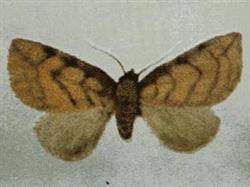Control of buckwheat hook-wing moth

Buckwheat hook-wing moth belongs to Lepidoptera, Noctuidae, adults 10-13 mm long, wingspan 30-36 mm, forewings have 3 outward curved ">"-shaped yellow-brown lines. The length of the larvae is 20-30 mm. The young larvae are green or grayish brown. With the increase of the instar, the larvae gradually change to dark brown, and the mature larvae are dirty white. The insect mainly harms buckwheat larvae and is gluttonous. When it is serious, the yield is reduced by more than 50%, even resulting in no harvest. The recent temperature and humidity conditions are very conducive to the occurrence and damage of buckwheat hook-wing moth, so growers need to actively carry out investigation and control. Prevention and control measures 1. Artificial killing makes use of the false death of larvae and can be killed artificially. The method is to take a sieve in one hand, beat the buckwheat plant in the other, let it fall in the sieve and concentrate on killing it. 2. Chemical control before the 3rd instar of the larvae, spray control was carried out with BT powder 800-1000 times, 4.5% cypermethrin 2000-2500 times, or 20% methamphetamine EC 1500-2000 times. Safety precautions when using chemicals, the dose must be dispensed in accordance with the instructions to prevent excessive dose from causing drug damage (buckwheat is in flowering and drug resistance is poor), wear protective clothing, glasses and gloves when spraying, and at the same time set up spraying signs to prevent human and animal poisoning.
- Prev

Cultivation techniques for stable and High yield of Buckwheat
Mustard belongs to seed plant phylum, angiosperm class, dicotyledonous plant Polygonaceae. The variety has high nutritional value, cool, anti-inflammatory, help digestion, anti-aging and other health functions, with an average yield of about 100 kg per mu. Increase buckwheat per unit yield, increase total yield, to promote catering industry, processing industry, medicine and health care industry development.
- Next

Key points of planting techniques of buckwheat
The growth period of buckwheat is short, and it can mature in 80 days. The key points of high-yield cultivation techniques of buckwheat are as follows: 1. Fine ground preparation. The unearthing ability of buckwheat seedlings is weak, so we should pay attention to fine soil preparation and create an environment conducive to the growth and development of buckwheat seedlings. two。 High quality sowing. Before and after buckwheat the Beginning of Autumn.
Related
- The first cup of black tea in spring, the flavor and history of tea gardens in Kenya, Africa
- The computer can not only choose potatoes, but also grow tea rice. AI will grow winter oolong tea champion.
- It is not only the inflated tea bitten by insects, but also engraved with the four seasons tea in Beipu.
- The Oriental Beauty Tea Festival in Zhuxian County takes the stage at the weekend to experience the plus-size feast of oil tea.
- & quot; Oriental Beauty Tea & Exploration of Emei in Hsinchu, the hometown of quot;
- The new variety of strawberry "Tainong 1" dessert is the first choice with mellow aroma. Crimson gorgeous
- History of Tea in Taiwan: from Wild Inner Mountain to Export Tea Garden
- Two types of Taiwan Oriental Beauty Black Tea won the British three-Star Award for Childhood Tea Xiang Zhang Jiaqi changed from pilot to champion tea maker.
- Banana species and varieties: the planting history of Taiwan Xianren banana and dwarf banana is long, is banana disease resistant?
- Coffee planting Technology: Qianjie Coffee from Seedling to harvesting

